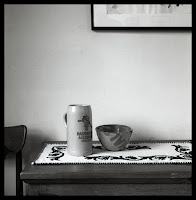Why did I do this, anyway?
That's a very good question. Nineteen years ago (well, not quite since it's 10 days short) I started this blog. It's not that I posted every day or even every week. That said, the total is about 75,000 words. The very first post (reprinted below) was my motive, or maybe justification or rationale, for adding to the Mississippi River flood of stuff on the internet.
After I finished the previous post I idly clicked on "older posts" and reread my first post. This popped out at me: "how irritated I get at the lack of coverage of visual art in my local media -- and how lame the little coverage that visual art does get seems." Alas, that hasn't changed and I really didn't have any expectation that what I posted would trigger a change but I'm sad that it hasn't. In fact it has gotten worse.
So with thanks to my loyal followers (all eight of you), the random visitors who have left comments from time to time, and those who read but didn't leave any tracks -- this will be the last post on NOT BAD BUT IS IS ART and I'll take the blog down when I can figure out how to do so. I now have a mostly-monthly newsletter "The Occasional Rumour" to which you can subscribe on my website www.ronfstop.com if you want to keep up with my own photography.
--------------------------------------------------------------------
DECEMBER 29, 2009
Why am I doing this, anyway?
That's a very good question -- it's not as if I have a lot of time hanging heavy on my hands. I suppose my biggest single reason for doing a blog about art is how irritated I get at the lack of coverage of visual art in my local media -- and how lame the little coverage that visual art does get seems.
The immediate spur came from my friend, Joe, giving me a full-page article from the NY Times of Sunday, November 8. It is about one of my heroes, Bruce Davidson, whose work is the subject of a new, three-volume retrospective published by Steidl as well as two concurrent shows in New York. The article is informative, witty, carefully researched, and articulate. It is accompanied by several photographs by Mr. Davidson and an excellent environmental portrait of him by a NYT staffer, Damon Winter.
Dang, what a concept! Real writing and in some quantity about visual art? I'll bet I would have to scrape bits and pieces from the local paper for at least a month to make up a full page. The only bit I can remember from the last few weeks that was accompanied by a photograph was about the closing of Benham Gallery (that, by the way, was the best and longest running photography gallery in Seattle). Oops, I let slip where I live (almost) so you can now identify the local paper. Oh, well. I might as well add that they just finished a three-part, front page series of articles on sports fans.
Not to be entirely down on the local Times, they do have reasonably good coverage of books since Seattle is a very bookish town. They do have reasonably good coverage on music, even classical. They have reasonably good coverage of movies, especially the Film Festival and NW Film Forum. Visual art? Well, not so much. When Seattle Art Museum has a blockbuster show it gets some coverage. The other museums and the galleries ... pretty slim.
A couple of years ago a new magazine "City Arts" appeared on the scene with three localized editions. It is a side effect of the publishing company that does the excellent programs for most of the local performing art venues -- opera, symphony, ballet, theater. What a good idea. It looked promising for a while. Between the economy flop and their merge with the local music magazine, the prospect for a lot of visual art coverage beyond the calendar doesn't look good. Their feature articles are beginning to look sort of like "what the hip artist is wearing".
Why me?
Another excellent question. I do not claim to be an authority. I do not have a degree in art history or studio art. I don't even claim to be an artist. I am a photographer. Some of what I do is art, some is just for fun, most of it is rubbish -- just like every other photographer, painter, sculptor, (writer). I read about art a lot. I look at a lot of art. I have a lot of strong opinions about art. Considering a lot of what gets published, I'm not a really bad writer.
So why not me? I have no good notion of how this blog is going to help, how it is going to shape up, even how long or how often I will continue to write for it.






